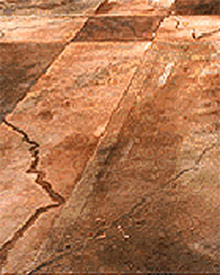 |
||||||
| July 13, 2004
In This Issue of The Acid Staining Newsletter Some Tricks with Masking Tape
My informant said that this trick is such common knowledge amongst housepainters that big hairdryers are often sold in the paint department of large home improvement stores. We have had some problems, as well, with removing tape from walls we have masked four or five days previously, when we began the cleaning and staining process. The problem is especially acute if the painter was lazy and sprayed latex on the walls right over the dust left behind by the drywall sanders. The latex paint is then just a thin plastic skin floating on a layer of dust. It looks fine until you rub it or try to stick a piece of tape upon it. When we remove the masking from such walls, we pull up large scabs of this paint skin. It does no good to point a finger at the painters-they are long gone from the jobsite and you are the one standing there with paint-covered masking tape in your hand! We have always preferred 3-M Brand Professional 24-hour masking tape because it gives us fewer problems than the cheaper brands. By the way, the most expensive brands of masking tape have LESS adhesive power, rather than more. The cheapest and thinnest tapes will drive you wild, as they stick to themselves so tightly on the roll that you tear them to bits just trying to unroll them. Even high quality tape will do this, if it is too old, or has been exposed to too much ultraviolet light. I keep all our masking tape in a dark cabinet and "rotate the stock." I wish we could buy it by the case, but we do not use it up rapidly enough. Masking tape, like cheese, does not keep well for more than two months. Here is masking tape trick #2. Most of you have probably removed dog or cat hair from a dark jacket by making a loop of masking tape, putting it on your hand, and rolling it over the hair-covered areas. It sure beats pulling the vacuum out of the closet and putting it together every time Fluffy rolls around on your velveteen couch. We were having problems with applying clear epoxy on a floor using the short-napped, pink, paint roller covers with "phenolic cores." These are the perfect rollers to use to apply clear, solvent-based acrylic sealers, since the glue which holds most roller covers together will dissolve in solvent-sealers and come apart while you are in the middle of a large, sticky floor. We were finding, however, that some of the pink fluff from the roller was falling into our clear sealers and epoxies. The solution is to wrap masking tape around each new roller cover, then pull it off, before mounting it on the roller handle. Do this two times, and you will remove all loose bits of fluff before you first immerse the roller in a tray of sealer. A more mundane use for masking tape is in making instant labels. Each one of our crew members has several kinds of tape and black felt-tipped pens in his or her tool bucket. We are often custom-mixing stain colors and decanting them into bottles which retain their old labels. If this stain gets returned to the trailer without being properly labeled, it might as well be thrown out. We have also prevented some severe accidents by labeling buckets of the acid-water dilutions we sometimes use to pre-etch floors, so that another crew member does not grab the same bucket thinking that it contains only water. It only takes a moment to make a masking tape label, but a splash of acid in the eyes can ruin your whole day. Happy Staining! GG Questions or comments about my newsletter? |
||||||
|
|
||||||

